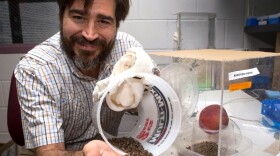Salmonella outbreaks can be devastating.
To reduce this danger, Arun Bhunia, professor of food microbiology at Purdue University, is working on new techniques and technology that will more quickly identify the infectious strain.
Dr. Arun Bhunia is a professor of food microbiology at Purdue University. His research focuses on pathogen detection and mechanism of pathogenesis. He earned a Ph.D. in food microbiology from University of Wyoming in 1989
Arun Bhunia - Better Salmonella Detection
Quickly detecting Salmonella bacteria in the food system can significantly reduce the risks of Salmonella outbreaks and the illness that can result.
Current methods of identifying Salmonella are complex and can take more than 72 hours. But at Purdue, we've developed a laser sensor known as "BARDOT" (pronounced bar-DOH') that identifies Salmonella in food samples in less than 24 hours. This could allow us to detect Salmonella much earlier and more easily—and would ultimately help food processors provide safer products to consumers.

BARDOT uses a laser to scan bacterial colonies growing on an agar plate. When the laser shines through a colony, it produces a black-and-white image called a "scatter pattern," a distinct set of rings and spokes. Because each type of bacterium generates a unique scatter pattern, this image serves as a "fingerprint" by which we can identify the bacterium.
BARDOT can identify Salmonella grown from samples of contaminated chicken, spinach, peanut butter, and so forth, with an accuracy of more than 95 percent. It can also distinguish serovars of Salmonella. Being able to identify a particular serovar can help food processors track Salmonella back to the original source of contamination.
One of the challenges is that there can be multiple kinds of bacteria in a sample, some of them pathogenic, some non-pathogenic. While we've focused on pinpointing Salmonella, we also found that BARDOT can identify other key foodborne pathogens including E. coli, Vibrio, Listeria, and Bacillus in a single scan. We are just now getting a sense of what it can do.





